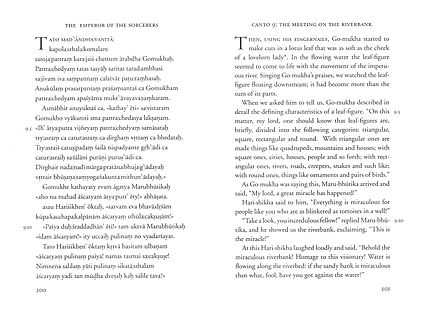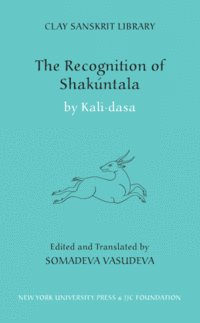- Clay Sanskrit Library
-
The Clay Sanskrit Library is a series of books published by New York University Press and the JJC Foundation. Each work features the text in its original language (transliterated Sanskrit) on the left-hand page, with its English translation on the right. The series was modeled on the Loeb Classical Library,[1] and its volumes are bound in teal cloth.
Contents
CSL and the JJC Foundation
The JJC Foundation was founded by John P. Clay and his wife, Jennifer. John Clay, who was born in Paterson, New Jersey, in 1934, went to Oxford University in the 1950s, where he studied classics and Sanskrit literature. He went on to a long career in global investment banking with Clay Finlay, Inc, New York, and Vickers da Costa, New York. But in 1999 he decided that he wanted to return to his real passion, Sanskrit literature, and envisioned a series that would make all the classics available to the general public for the first time. He shared his vision for the Clay Sanskrit Library with Richard Gombrich, Boden Professor of Sanskrit at Oxford University from 1965 to 2004, and Richard Gombrich agreed to serve as general editor of the series. They invited Somadeva Vasudeva and Isabelle Onians (themselves Sanskrit scholars) as associate editors for the series, as well as thirty leading academics from eight different countries to produce new translations of classical Sanskrit literature. John Clay now lives in New York City. In 2007 Sheldon Pollock joined Richard Gombrich as co-general editor. Richard Gombrich resigned from the post in early 2008.
The first books in the series were published in 2005. At present, there are 46 volumes available.
Current Volumes
Epic
- Maha·bhárata II: The Great Hall (Sabhāparvan): 588 pp, Paul Wilmot, 2006, ISBN 978-0-8147-9406-7
- Maha·bhárata III: The Forest (Vanaparvan) (volume four of four): 374 pp, William J. Johnson, 2005, ISBN 978-0-8147-4278-5
- Maha·bhárata IV: Viráta (Virāṭaparvan): 516 pp, Kathleen Garbutt, 2007, ISBN 978-0-8147-3183-3
- Maha·bhárata V: Preparations for War (Udyogaparvan) (volume one of two): 450 pp, Kathleen Garbutt, with a foreword by Gurcharan Das, 2008, ISBN 978-0-8147-3191-8
- Maha·bhárata V: Preparations for War (Udyogaparvan) (volume two of two): 789 pp, Kathleen Garbutt, 2008, ISBN 978-0-8147-3202-1
- Maha·bhárata VI: Bhishma (Bhīṣmaparvan) (volume one of two) Including the “Bhagavad Gita” in Context: 615 pp, Alex Cherniak, Foreword by Ranajit Guha, 2008, ISBN 978-0-8147-1696-0
- Maha·bhárata VI: Bhishma (volume two of two): 582pp, Alex Cherniak, 2009, ISBN 978-0-8147-1705-9
- Maha·bhárata VII: Drona (Droṇaparvan) (volume one of four): 473 pp, Vaughan Pilikian, 2006, ISBN 978-0-8147-6723-8
- Maha·bhárata VII: Drona (Droṇaparvan) (volume two of four): 394 pp, Vaughan Pilikian, 2009, ISBN 978-0-8147-6776-4
- Maha·bhárata VIII: Karna (Karṇaparvan) (volume one of two): 604 pp, Adam Bowles, 2007, ISBN 978-0-8147-9981-9
- Maha·bhárata VIII: Karna (Karṇaparvan) (volume two of two): 624 pp, Adam Bowles, 2008, ISBN 978-0-8147-9995-6
- Maha·bhárata IX: Shalya (Śalyaparvan) (volume one of two): 371 pp, Justin Meiland, 2005, ISBN 978-0-8147-5706-2
- Maha·bhárata IX: Shalya (Śalyaparvan) (volume two of two): 470 pp, Justin Meiland, 2007, ISBN 978-0-8147-5737-6
- Maha·bhárata X & XI: Dead of the Night & The Women (Sauptikaparvan & Strīparvan): 416 pp, Kate Crosby, 2009, ISBN 978-0-8147-1727-1
- Maha·bhárata XII: Peace (Śāntiparvan): “The Book of Liberation” (volume three of five): 626 pp, Alex Wynne, 2009, ISBN 0-8147-9453-X
- Ramáyana I: Boyhood (Bālakāṇḍa): 424 pp, Robert P. Goldman, 2005, ISBN 0-8147-3163-5
- Ramáyana II: Ayódhya (Ayodhyākāṇḍa): 652 pp, Sheldon I. Pollock, 2005, ISBN 0-8147-6716-8
- Ramáyana III: The Forest (Araṇyakāṇḍa): 436 pp, Sheldon I. Pollock, 2006, ISBN 0-8147-6722-2
- Ramáyana IV: Kishkíndha (Kiṣkindhākāṇḍa): 415 pp, Rosalind Lefeber, 2005, ISBN 0-8147-5207-1
- Ramáyana V: Súndara (Sundarakāṇḍa): 538 pp, Robert P. Goldman & Sally J. Sutherland Goldman, 2006, ISBN 0-8147-3178-3
Classical poetry
- The Birth of Kumára (Kumārasaṃbhava) by Kālidāsa. 360 pp, David Smith, 2005, ISBN 0-8147-4008-1
- Love Lyrics (Amaruśataka, Śatakatraya and Caurapañcāśikā) by Amaru, Bhartṛhari and Bilhaṇa. 327 pp, Greg Bailey & Richard Gombrich, 2005, ISBN 0-8147-9938-8
- Messenger Poems (Meghadūta, Pavanadūta and Haṃsadūta) by Kālidāsa, Dhoyī and Rūpa Gosvāmin. 293 pp, Sir James Mallinson, 2006, ISBN 0-8147-5714-6
- Three Satires (Kaliviḍambana, Kalāvilāsa and Bhallaṭaśataka) by Nīlakaṇṭha, Kṣemendra and Bhallaṭa. 403 pp, Somadeva Vasudeva, 2005, ISBN 0-8147-8814-9
- Gita·govínda: Love Songs of Radha and Krishna by Jayadeva. Foreword by Sudipta Kaviraj. 256 pp, Lee Siegel, 2009, ISBN 0-8147-4078-2
- “Bouquet of Rasa” and “River of Rasa” by Bhānudatta. 442 pp, Sheldon I. Pollock, 2009, ISBN 0-8147-6755-9
- Bhatti’s Poem: The Death of Rávana by Bhaṭṭi. 566 pp, Oliver Fallon, 2009, ISBN 0-8147-2778-6
- On Self-Surrender, Compassion, and the Mission of a Goose: Sanskrit Poetry from the South by Appayya Dīkṣita and Vedāntadeśika, Yigal Bronner & David Shulman, 2009, ISBN 0-8147-4110-8
Drama
- The Lady of the Jewel Necklace and The Lady who Shows her Love (Ratnāvalī and Priyadarśikā) by Harṣa: 514pp, Wendy Doniger, 2007, ISBN 978-0-8147-1996-1
- Much Ado About Religion (Āgamaḍambara) by Bhaṭṭa Jayanta: 320 pp, Csaba Dezső, 2005, ISBN 0-8147-1979-1
- Rákshasa’s Ring (Mudrārākṣasa) by Viśākhadatta: 385 pp, Michael Coulson, 2005, ISBN 0-8147-1661-X
- Rama Beyond Price (Anargharāghava) by Murāri: 638 pp, Judit Törzsök, 2006, ISBN 0-8147-8295-7
- The Recognition of Shakúntala (Abhijñānaśākuntala, Kashmir Recension) by Kālidāsa: 419 pp, Somadeva Vasudeva, 2006, ISBN 0-8147-8815-7
- Rama’s Last Act (Uttararāmacarita) by Bhavabhūti: 458 pp, Sheldon I. Pollock, with a foreword by Girish Karnad, 2007, ISBN 978-0-8147-6733-7
- How the Nagas were Pleased (Nāgānanda) by Harṣa and The Shattered Thighs (Ūrubhaṅga) by Bhāsa: 376 pp, Andrew Skilton, 2009, ISBN 0-8147-4066-9
- Little Clay Cart by Śūdraka. Foreword by Partha Chatterjee: 674 pp, Diwakar Acharya, 2009, ISBN 0-8147-0729-7
- How Úrvashi Was Won by Kālidāsa: 566 pp, Velcheru Narayana Rao & David Shulman, 2009, ISBN 0-8147-2778-6
- The Quartet of Causeries by Śūdraka, Śyāmilaka, Vararuci & Īśvaradatta, Csaba Dezső & Somadeva Vasudeva, 2009, ISBN 0-8147-1978-7
Other narrative
- The Emperor of the Sorcerers (Bṛhatkathāślokasaṃgraha) by Budhasvāmin (volume one): 452 pp, Sir James Mallinson, 2005, ISBN 0-8147-5701-4
- The Emperor of the Sorcerers (Bṛhatkathāślokasaṃgraha) by Budhasvāmin (volume two): 467 pp, Sir James Mallinson, 2005, ISBN 0-8147-5707-3
- The Epitome of Queen Lilávati (Līlāvatīsāra) by Jinaratna (volume one): 543 pp, R.C.C. Fynes, 2005, ISBN 0-8147-2741-7
- The Epitome of Queen Lilávati (Līlāvatīsāra) Jinaratna (volume two): 650 pp, R.C.C. Fynes, 2006, ISBN 0-8147-2742-5
- Five Discourses on Worldly Wisdom (Pañcatantra) by Viṣṇuśarman: 562 pp, Patrick Olivelle, 2006, ISBN 0-8147-6208-5
- Heavenly Exploits (Divyāvadāna): 444 pp, Joel Tatelman, 2005, ISBN 0-8147-8288-4
- The Ocean of the Rivers of Story (Kathāsaritsāgara) by Somadeva (volume one of seven): 556 pp, Sir James Mallinson, 2007, ISBN 978-0-8147-8816-5
- The Ocean of the Rivers of Story (Kathāsaritsāgara) by Somadeva (volume two of seven): 608 pp, Sir James Mallinson, 2009, ISBN 0-8147-9558-7
- What Ten Young Men Did (Daśakumāracarita) by Daṇḍin: 651 pp, Isabelle Onians, 2005, ISBN 0-8147-6206-9
- “Friendly Advice” and “King Víkrama’s Adventures” (Hitopadeśa and Vikramacarita) by ISBN 978-0-8147-8305-4
- Handsome Nanda (Saundarananda) by Aśvaghoṣa: 392 pp, Linda Covill, 2007, ISBN 978-0-8147-1683-0
- Life of the Buddha by Aśvaghoṣa: 561 pp, Patrick Olivelle, 2008, ISBN 978-0-8147-6216-5
- Garland of the Buddha’s Past Lives (volume one of two) by Āryaśūra: 548 pp, Justin Meiland, 2009, ISBN 0-8147-9581-1
To Appear in August 2009
Garland of the Buddha’s Past Lives (volume two of two) by Āryaśūra, Justin Meiland.
Princess Kadámbari (volume one of three) by Bāṇa, David Smith.
Málavika and Agni·mitra by Kālidāsa, Daniel Balogh & Eszter Somogyi.
Seven Hundred Elegant Verses by Govardhaṇa, Friedhelm Hardy.
The Rise of Wisdom Moon by Kṛṣṇamiśra, Matthew Kapstein.Notes
- ^ Eric Banks, "100 Paths to Nirvana", Bookforum Dec./Jan. 2006.
External links
- Clay Sanskrit Library (official page)
Categories:- Sanskrit texts
- Dual-language series of texts
Wikimedia Foundation. 2010.


